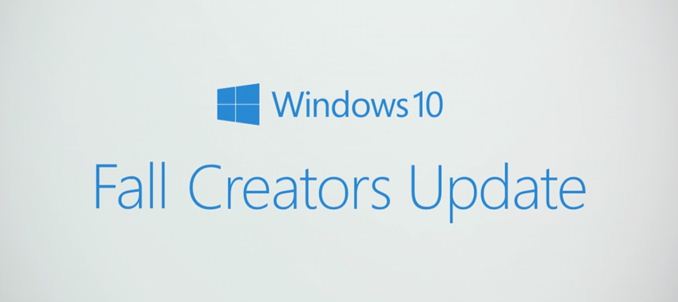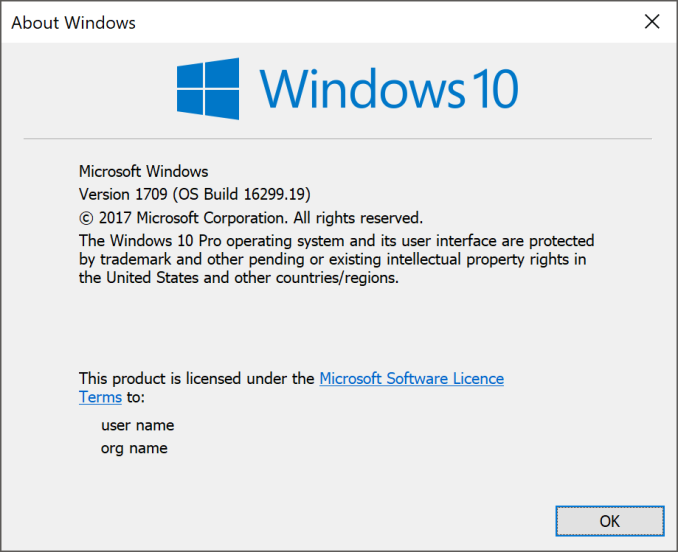The Windows 10 Fall Creators Update Feature Focus
by Brett Howse on November 10, 2017 8:00 AM EST
Windows 10 has finally settled into a groove. We are just over two years from the initial release of Windows 10. Part of the promise of Windows 10 was Windows as a service, or in other words, continual updates to Windows rather than monolithic version releases every couple of years. However, the haphazard schedule of feature updates was not pleasing to one stable customer of Microsoft’s. Businesses don’t love surprises, and they need time to plan ahead, and test, in order to deliver the vision that Microsoft has envisioned for Windows 10 going forward, so 2017 is the first year we get to see the new spring and fall updates, first with the Creators Update on April 11, 2017, and now the Fall Creators Update which became widely available on October 17, 2017.
The biannual release schedule still might be too aggressive for a lot of enterprises, but it’s a balancing act for Microsoft to keep the features coming for consumers, security updates coming for enterprise, and of course, keeping Windows 10 fresh in the eyes of everyone. Hopefully this new schedule works out though, since it’s nice to see fewer, smaller updates, rather than annual massive updates which may cause even more challenges.
| Windows 10 Version History | |||||
| Version | Version Number | Release Date | |||
| Windows 10 Original Release | 1507 | July 29, 2015 | |||
| November Update | 1511 | November 10, 2015 | |||
| Anniversary Update | 1607 | August 2, 2016 | |||
| Creators Update | 1703 | April 5, 2017 | |||
| Fall Creators Update | 1709 | October 17, 2017 | |||
And a smaller update is arguably what we’ve had for both of the 2017 releases for Windows, and that’s certainly not a bad thing. That’s not to take away from the many small changes and fixes under the hood, but more a fact that Windows 10 is solid, and stable, and updates only need to further smooth out some of the rough spots, and add a few new ideas for people to utilize. Windows 10 is now well known, with an official monthly active user base of over 500 million devices. It’s a solid number, despite being well under initial targets at launch.
With the Fall Creators Update, Microsoft has added quite a few new features, including some that missed out on the April update. They’ve taken the first step towards an improved OS and app design language since Windows 10 first launched, they’ve added more accessibility, more security, and finally added one of the top feature requests since Windows 10 launched. Let’s dig into the changes.












95 Comments
View All Comments
blackmagnum - Friday, November 10, 2017 - link
Free is free, right? Microsoft, keep them coming a the timely manner and I just might turn on Full Diagnostic data for you.ddriver - Friday, November 10, 2017 - link
I like how you think that turning it off somehow keeps your data safer ;)"Bullwinkle J Moose" - Friday, November 10, 2017 - link
Speaking of keeping your data safer......Here is a juicy quote>
"One thing you still can’t do is actually view the site certificate. The information provided by Edge is very basic, with no option to open the certificate in the more advanced Windows certificate tools to check the trust chain"
Also irrelevant to the "Improved" security claim
Microsoft still lets most "trusted" software through the Firewall by default as long as they have a "Valid" certificate
Yes, Microsoft lets malicious copies of CCleaner, VLC and pretty much all the other "trusted" applications who have been in the news lately because they had "Valid" certificates for compromised installers (Directly from the manufacturer B.T.W.)
Microsoft should block ALL applications by default (both sending and receiving) including ALL Windows components and telemetry "IF" they were concerned about end user security, but they are not
Microsoft now has all the telemetry they need to improve their products for older hardware so why won't they turn it off?
Because it's a Spyware Platform!
You can't really spy on EVERYONE if you close all the backdoors.....DUH!
and sending encrypted messages won't help you if the NSA is watching you type the message!
Double DUH!
5080 - Friday, November 10, 2017 - link
I hope you don't use any Intel CPU's if you're that concerned about spy ware in your system. The Intel Management Engine or ME is spying on you even of your system is powered down.Google is working on a solution to kill the MINIX based ME, but they haven't figured out how to do it yet without disabling some of the CPU's features.People don't really care about the collection of telemetry data, if they would really care than no one would buy any more cell phones, Chromebooks or Windows PC's. It has become a part of how we consume and use this devices.
"Bullwinkle J Moose" - Friday, November 10, 2017 - link
Oh you are so wrong 5080The Intel Management Engine is disabled and has never been used on ANY of my computers
There is even an app you can download and check whether or not it is enabled
Never EVER installed the ME software either
I could see this problem coming 10 years ago!
5080 - Friday, November 10, 2017 - link
Intel constantly "optimized" ME on their CPU's. Who knows, when they can activate this without user consent. The disturbing part is that the option is there.linuxgeex - Saturday, November 11, 2017 - link
Actually, unless you specifically purchased a mobo with Coreboot, you have an active ME and you just don't know it.negusp - Saturday, November 11, 2017 - link
Lol yeah he's a retard. Any recent Intel CPU needs a couple BIOS pages wiped to have the ME disabled.shabby - Friday, November 10, 2017 - link
Could of swore that needed an intel network card to fully function."Bullwinkle J Moose" - Friday, November 10, 2017 - link
Correct ShabbyI think Steve Gibson covered that in a Security Now video